#David S LaForce
Text

"Pellinore hunts a strange unique creature, the Questing Beast, which his family is fated to pursue, though neither they nor anybody else will ever catch it." (Diesel / David S LaForce, "Arthurian Heroes" section of AD&D Deities & Demigods, TSR, 1980) The Beast Glatisant, the Questing Beast, is not given its own heading or stats in this volume, but the illustration matches some medieval accounts of a creature with stag's feet, a serpent's head, leopard's body, and lion's haunch and tail. So: hooved, long neck, spotted, yellow/orange/brown in color, with a darker bushier tail tip, all point to it being based on misunderstood descriptions of a giraffe.
#D&D#Dungeons & Dragons#David S LaForce#Deities & Demigods#King Pellinore#medieval#Questing Beast#Beast Glatisant#Diesel#Arthuriana#Arthurian legend#Arthurian heroes#giraffe#AD&D#dnd#bestiary#1980s#Dungeons and Dragons#TSR
264 notes
·
View notes
Photo
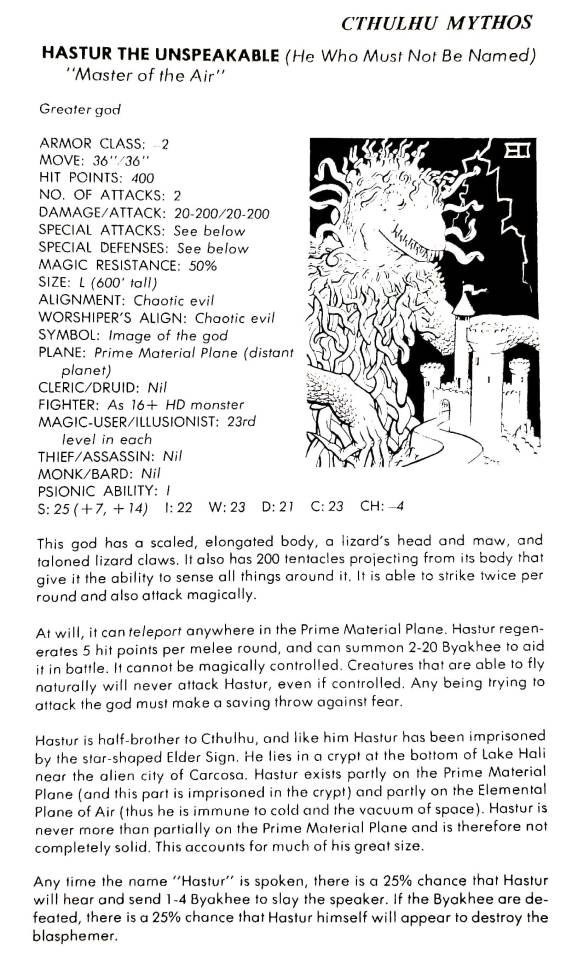

Image description: two scans from the 1980 edition of the TSR Advanced Dungeons and Dragons sourcebook Deities and Demigods. The first is of the text accompanying the entry for Hastur, a full transcript of which is under a readmore link. The second is a close-up of the illustration and depicts a lizard like creature covered in tentacles behind a castle. It is considerably larger than the castle and there is a bolt of lightning in the background. The upper right corner has a stylized signature of the letters E and O, indicating that Erol Otus is the illustrator of this particular image.
End image description.
My dad owns a copy of the Deities and Demigods book from before the copyright strike, and I haven’t seen any scans of Hastur from it around tumblr so. Here it is! The whole thing is very influenced by August Derleth’s interpretation of the Cthulhu Mythos, and I have Opinions about that, but this is specifically where the “don’t say Hastur’s name more than four times or he’ll come Get You” thing comes from, which I think is a very neat bit of history and trivia!
One other thing I find interesting is that there is no mention of The King in Yellow (the play) in this section. There is also no mention of the Yellow Sign, Cassilda, or Camilla, though Lake Hali and Carcosa are mentioned as part of an “alien planet”.
The book is credited to James M. Ward and Robert J. Kuntz, and edited by Lawrence Schick.
The illustrations are credited to the following: Jeff Dee, Erol Otus, Eymoth, Darlene Pekul, Paul Jaquays, Jim Roslof, David S. LaForce, David C. Sutherland III, Jeff Lanners, and D. A. Trampier.
Text transcript is as follows:
HASTUR THE UNSPEAKABLE (He Who Must Not Be Named) “Master of the Air”
Greater God
ARMOR CLASS: -2
MOVE: 36″/36″
HIT POINTS: 400
NO. OF ATTACKS: 2
DAMAGE/ATTACK: 20-200/20-200
SPECIAL ATTACKS: See below
SPECIAL DEFENSES: See below
MAGIC RESISTANCE: 50%
SIZE: L (600′ TALL)
ALIGNMENT: Chaotic evil
WORSHIPER’S ALIGN: Chaotic evil
SYMBOL: Image of the god
PLANE: Prime Material Plane (distant planet)
CLERIC/DRUID: Nil
FIGHTER: As 16+ HD monster
MAGIC-USER/ILLUSIONIST: 23rd level in each
THIEF/ASSASSIN: Nil
MONK/BARD: Nil
PSIONIC ABILITY: I
S: 25 (+7. +14) I: 22 W: 23 D: 21 C: 23 CH: -4
This god has a scaled, elongated body, a lizard’s head and maw, and taloned lizard claws. It also has 200 tentacles projecting from its body that give it the ability to sense all things around it. It is able to strike twice per round and also attack magically.
At will, it can teleport anywhere in the Prime Material Plane. Hastur regenerates 5 hit points per melee round, and can summon 2-20 Byakhee to aid it in battle. It cannot be magically controlled. Creatures that are able to fly naturally will never attack Hastur, even if controlled. Any being trying to attack the god must make a saving throw against fear.
Hastur is half-brother to Cthulhu, and like him Hastur has been imprisoned by the star-shaped Elder Sign. He lies in a crypt at the bottom of Lake Hali near the alien city of Carcosa. Hastur exists partly on the Prime Material Plane (and this part is imprisoned in the crypt) and partly on the Elemental Plane of Air (thus he is immune to cold and the vacuum of space). Hastur is never more than partially on the Prime Material Plane and is therefore not completely solid. This accounts for much of his great size.
Any time the name “Hastur” is spoken, there is a 25% chance that Hastur will here and send 1-4 Byakhee to slay the speaker. If the Byakhee are defeated, there is a 25% chance that Hastur himself will appear to destroy the blasphemer.
#cthulhu mythos#hastur#the king in yellow#dnd#carcosa#advanced dungeons and dragons#deities and demigods
106 notes
·
View notes
Text
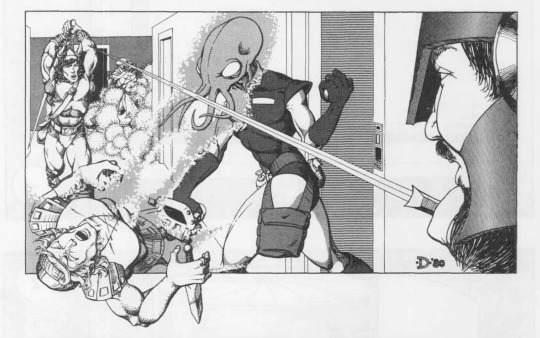
Adventure S3 - Expedition to the Barrier Peaks
Art: David S. LaForce
#dnd#dnd art#dungeons and dragons#d&d#advanced dungeons and dragons#old school#role playing games#rpg#ttrpg
4 notes
·
View notes
Photo

Elemental Demons (Gremlins) by David S. LaForce, The Dragon #37 (May, 1980)
#David S. LaForce#D&D#Dungeons & Dragons#AD&D#illustration#RPG#adventure#gremlin#demon#monster#creature#b&w#pipe#smoke#The Dragon#Dragon#fantasy#dilijáték#1980#1980s#RPG art
18 notes
·
View notes
Photo




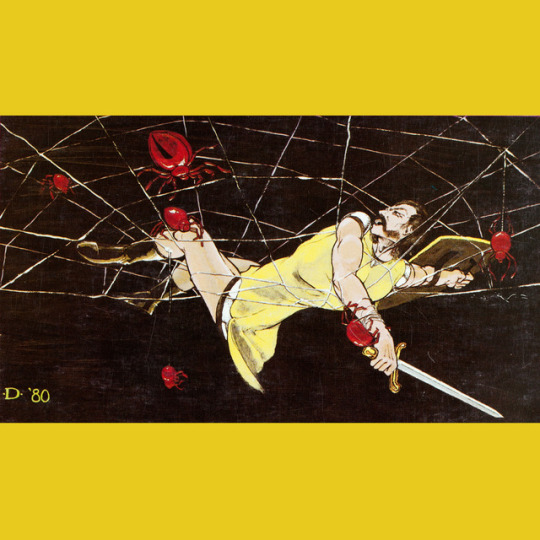
Q1 – Queen of the Demonweb Pits marks another first – it is (to my knowledge) the first time a module brought characters to another plane of existence, in this case the 66th level of the Abyss, the titular Demonweb Pits. It looks…strange. The mix of monsters, at a glance, is unusual, the landscape surreal and Lolth apparently flies around in a spider shaped ship of some kind (that perhaps anticipates Spelljammer, nine years later).
Another interesting anticipation – there are portal to other worlds that are of interest to Lolth and one of them sure sounds a lot like Ravenloft.
The strangest thing about the module is that it is rated for a party of level 10 to 14. And you know from the cover that you’re going to fight Lolth, a full on goddess. This begs a couple of questions about first edition D&D. Is level 14 a level you should start going around hunting gods and, if so, what do you do at level 15 and beyond?
More likely: level 14 is when you feel like you can take on a god but then, when you do, you get squished like a…well…spider.
Maybe I shouldn’t be so keen to get my DM to run this for us…
Side note: The front copy boasts it is the first of a series of other-planar scenarios, but to my knowledge, no such series manifested.
Art note: there’s quite a lot of nice art here by, Davis S. LaForce, Jeff Dee and Jim Roslof, but of special note is Erol Otus’ two interpretations of Lolth: the one in the spiderweb bikini and the one with a lady head attached to a spider head. Suprisingly, neither caught on – later takes preferred a more drider-like spider centaur design, which combined the horrific and seductive aspects of the goddess more clearly. But man, that spider with a lady head is super creepy.
#D&D#AD&D#dungeons & dragons#advanced dungeons & dragons#TSR#RPG#tabletop rpg#Gary Gygax#Jim Roslof#DSL#David S. LaForce#1980#Erol Otus#Drow#Underdark#Lolth#Q1#Queen of the Demonweb Pits#DSC#David C Sutherland III#Ravenloft#Spelljammer#Drider#Abyss
20 notes
·
View notes
Text
42 e cérémonie des césar
Meilleur film
Elle de Paul Verhoeven, produit par Saïd Ben Saïd et Michel Merkt
Divines de Houda Benyamina, produit par Marc-Benoît Créancier
Frantz de François Ozon, produit par Éric Altmayer et Nicolas Altmayer
Les Innocentes d'Anne Fontaine, produit par Éric et Nicolas Altmayer et Philippe Carcassonne
Ma Loute de Bruno Dumont, produit par Jean Bréhat, Rachid Bouchareb et Muriel Merlin
Mal de pierres de Nicole Garcia, produit par Alain Attal
Victoria de Justine Triet, produit par Emmanuel Chaumet
Meilleur réalisateur
Xavier Dolan pour Juste la fin du monde
Houda Benyamina pour Divines
François Ozon pour Frantz
Bruno Dumont pour Ma Loute
Anne Fontaine pour Les Innocentes
Nicole Garcia pour Mal de pierres
Paul Verhoeven pour Elle
Meilleur acteur
Gaspard Ulliel pour le rôle de Louis dans Juste la fin du monde
François Cluzet pour le rôle du docteur Werner dans Médecin de campagne
Pierre Deladonchamps pour le rôle de Mathieu dans Le Fils de Jean
Manu Payet pour le rôle d'Eddie dans Damoclès
Fabrice Luchini pour le rôle d'André Van Peteghem dans Ma Loute
Pierre Niney pour le rôle d'Adrien Rivoire dans Frantz
Omar Sy pour le rôle de Rafael Padilla dans Chocolat
Meilleure actrice
Isabelle Huppert pour le rôle de Michèle Leblanc dans Elle
Judith Chemla pour le rôle de Jeanne Le Perthuis des Vauds dans Une vie
Marion Cotillard pour le rôle de Gabrielle dans Mal de pierres
Virginie Efira pour le rôle de Victoria Spick dans Victoria
Marina Foïs pour le rôle de Constance dans Irréprochable
Sidse Babett Knudsen pour le rôle d'Irène Frachon dans La Fille de Brest
Soko pour le rôle de Loïe Fuller dans La Danseuse
Meilleur acteur dans un second rôle
James Thierrée pour le rôle de George Foottit dans Chocolat
Gabriel Arcand pour le rôle de Pierre dans Le Fils de Jean
Vincent Cassel pour le rôle d'Antoine dans Juste la fin du monde
Vincent Lacoste pour le rôle de Sam dans Victoria
Laurent Lafitte pour le rôle de Patrick dans Elle
Melvil Poupaud pour le rôle de Vincent dans Victoria
Meilleure actrice dans un second rôle
Déborah Lukumuena pour le rôle de Maimouna dans Divines
Nathalie Baye pour le rôle de Martine dans Juste la fin du monde
Valeria Bruni Tedeschi pour le rôle d'Isabelle Van Peteghem dans Ma Loute
Anne Consigny pour le rôle d'Anna dans Elle
Mélanie Thierry pour le rôle de Gabrielle dans La Danseuse
Meilleur espoir masculin
Niels Schneider pour le rôle de Pier Ulmann dans Diamant noir
Jonas Bloquet pour le rôle de Vincent dans Elle
Damien Bonnard pour le rôle de Léo dans Rester vertical
Corentin Fila pour le rôle de Tom dans Quand on a 17 ans
Kacey Mottet-Klein pour le rôle de Damien dans Quand on a 17 ans
Meilleur espoir féminin
Oulaya Amamra pour le rôle de Dounia dans Divines
Paula Beer pour le rôle d'Anna dans Frantz
Lily-Rose Depp pour le rôle d'Isadora Duncan dans La Danseuse
Noémie Merlant pour le rôle de Sonia dans Le ciel attendra
Raph pour le rôle de Billie Van Peteghem dans Ma Loute
Meilleur scénario original
L'Effet aquatique – Sólveig Anspach et Jean-Luc Gaget
Divines – Romain Compingt, Houda Benyamina et Malik Rumeau
Les Innocentes – Sabrina B. Karine, Alice Vial, Pascal Bonitzer et Anne Fontaine
Ma Loute – Bruno Dumont
Victoria – Justine Triet
Meilleure adaptation
Ma vie de Courgette – Céline Sciamma, d'après le roman Autobiographie d'une courgette de Gilles Paris
Elle – David Birke, d'après le roman Oh... de Philippe Djian
La Fille de Brest – Séverine Bosschem et Emmanuelle Bercot, d'après le livre Mediator 150 mg : combien de morts ? de Irène Frachon
Frantz – François Ozon, d'après la pièce de théâtre L'Homme que j'ai tué de Maurice Rostand
Mal de pierres – Nicole Garcia et Jacques Fieschi, d'après le roman Mal de pierres (Mal di pietre) de Milena Agus
Réparer les vivants – Katell Quillévéré et Gilles Taurand, d'après le roman Réparer les vivants de Maylis de Kerangal
Meilleurs décors
Chocolat – Jérémie D. Lignol
La Danseuse – Carlos Conti
Frantz – Michel Barthélémy
Ma Loute – Riton Dupire-Clément
Planetarium – Katia Wyszkop
Meilleurs costumes
La Danseuse – Anaïs Romand
Frantz – Pascaline Chavanne
Mal de pierres – Catherine Leterrier
Ma Loute – Alexandra Charles
Une vie – Madeline Fontaine
Meilleure photographie
Frantz – Pascal Marti
Elle – Stéphane Fontaine
Les Innocentes –Caroline Champetier
Ma Loute – Guillaume Deffontaines
Mal de pierres – Christophe Beaucarne
Meilleur montage
Juste la fin du monde – Xavier Dolan
Divines – Loïc Lallemand et Vincent Tricon
Elle – Job ter Burg
Frantz – Laure Gardette
Mal de pierres – Simon Jacquet
Meilleur son
L'Odyssée – Marc Engels, Fred Demolder, Sylvain Réty et Jean-Paul Hurier
Chocolat – Brigitte Taillandier, Vincent Guillon et Stéphane Thiébaut
Elle – Jean-Paul Mugel, Alexis Place, Cyril Holtz et Damien Lazzerini
Frantz – Martin Boissau, Benoît Gargonne et Jean-Paul Hurier
Mal de pierres – Jean-Pierre Duret, Syvlain Malbrant et Jean-Pierre Laforce
Meilleure musique originale
Dans les forêts de Sibérie – Ibrahim Maalouf
Chocolat – Gabriel Yared
Elle – Anne Dudley
Frantz – Philippe Rombi
Ma vie de Courgette – Sophie Hunger
Meilleur premier film
Divines de Houda Benyamina
Cigarettes et Chocolat chaud de Sophie Reine
La Danseuse de Stéphanie Di Giusto
Diamant noir de Arthur Harari
Rosalie Blum de Julien Rappeneau
Meilleur film d'animation
Ma vie de Courgette de Claude Barras
La Jeune Fille sans mains de Sébastien Laudenbach
La Tortue rouge de Michael Dudok de Wit
Meilleur film documentaire
Merci Patron ! de François Ruffin
Dernières nouvelles du cosmos de Julie Bertucelli
Fuocoammare, par-delà Lampedusa de Gianfranco Rosi
Swagger d'Olivier Babinet
Voyage à travers le cinéma français de Bertrand Tavernier
Meilleur film étranger
Moi, Daniel Blake (I, Daniel Blake) de Ken Loach • Royaume-Uni
Baccalauréat (Bacalaureat) de Cristian Mungiu • Roumanie
La Fille inconnue de Jean-Pierre et Luc Dardenne • Belgique
Juste la fin du monde de Xavier Dolan • Canada
Aquarius de Kleber Mendonça Filho • Brésil
Manchester by the Sea de Kenneth Lonergan • États-Unis
Toni Erdmann de Maren Ade • Allemagne
Meilleur court métrage
(ex-æquo)
Maman(s) de Maïmouna Doucouré
Vers la tendresse d'Alice Diop
Après Suzanne de Félix Moati
Au bruit des clochettes de Chabname Zariab
Chasse royale de Lise Akoka et Romane Gueret
Meilleur court métrage d'animation
Celui qui a deux âmes de Fabrice Luang-Vija
Café froid de François Leroy et Stéphanie Lansaque
Journal animé de Donato Sansone
Peripheria de David Coquard-Dassault
César d'honneur
George Clooney
4 notes
·
View notes
Text
ALZHEIMER: UM RISCO SE VOCÊ TIVER PROBLEMAS PARA REPETIR CERTAS FRASES
Um recente estudo internacional mostrou uma ligação entre a doença de Alzheimer e certos distúrbios de linguagem, levando as pessoas que percebem essas mudanças em seu discurso a consultarem rapidamente para detecção precoce.
RECOMENDAR ARTIGO
Dificuldade em encontrar palavras e repetir frases em uma pessoa na casa dos cinquenta pode indicar o início da doença de Alzheimer . Isto é revelado em um estudo internacional publicado em 21 de novembro de 2018 na revista Annals of Neurology .
Doença de Alzheimer: A partir dos 50 anos, um certo tipo de distúrbio de linguagem deve colocar a pulga no ouvido
Veja também: Alzheimer: seis dicas para evitar isso!
Se sabemos que os distúrbios de linguagem, como os da memória, são sintomas da doença de AlzheimerEste estudo mostra que estas são manifestações muito específicas e típicas de uma forma particular de patologia. Os pesquisadores acompanharam 1251 pacientes com três formas diferentes de afasia (perda total ou parcial da capacidade de comunicação): semântica (com transtorno de compreensão), não fluente (fluxo verbal reduzido) e logopênico. David Bergeron e Robert Jr. Laforce, autores do estudo, disseram à Canadian Press que "pessoas com este tipo de afasia sofrem de uma" falta da palavra ", repetidamente bloqueiam uma frase, elas lutam para encontrar suas palavras e eles dificilmente conseguem repetir uma frase que acaba de ser dita para eles.Isso dá conversas vagas, porque não se pode encontrar a palavra certa para esclarecer os pensamentos ".
PUBLICIDADE
Os pesquisadores descobriram que a taxa de beta-amilóide , uma proteína que é encontrada nos neurônios de pessoas com doença de Alzheimer, era anormalmente elevada em 86% dos pacientes com logopénique afasia , contra mais de 20% pacientes afetados por outras formas.
youtube
0 notes
Text
LeBron James: I wasn't 'blindsided' by reporter's postgame question about Erin Popovich
LeBron James: I wasn't 'blindsided' by reporter's postgame question about Erin Popovich
CLOSE The news of Erin Popovich’s passing was announced on Wednesday night, and support rolled in from across the NBA world. USA TODAY Sports Cleveland Cavaliers forward LeBron James reacts in the first quarter against the Brooklyn Nets.(Photo: David Richard, USAT) LeBron James says he wasn’t caught off guard by Allie LaForce’s question regarding the death of San Antonio Spurs head coach Gregg…
View On WordPress
0 notes
Photo

8 attacks per round for zero damage but miss a save, paralyzed might eat you might not some of us only eat fungus and cave mold we just don't like you bugging us DEAL WITH IT Carrion Crawler David S. LaForce Dungeons & Dragons: Basic Rulebook (1981)
7 notes
·
View notes
Photo

Nergal, Babylonian god of the underworld, who fights with a +5 shield that casts a death spell aura in a 30′ radius (Diesel / David S LaForce, AD&D Deities & Demigods, TSR, 1980) Unlike many of the historical gods, Nergal remained part of some D&D pantheons in later editions
#D&D#Dungeons & Dragons#David S LaForce#Nergal#AD&D#Deities & Demigods#Babylonian Mythos#Diesel#dnd#deity#god#Babylonia#death spell#magic shield#magic item#Dungeons and Dragons#TSR
160 notes
·
View notes
Photo
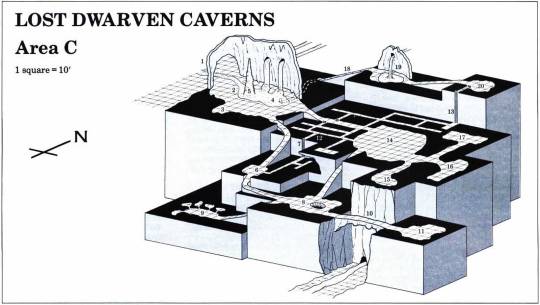
Lost Dwarven Caverns, isometric map by Diesel (David S LaForce) from “Visitors from Above,” Spelljammer adventure by Shonn Everett in Dungeon 28, March/April 1991
#D&D#Dungeons & Dragons#Diesel#David S LaForce#dungeon map#isometric dungeon map#Dungeon magazine#Spelljammer#lost dwarven caverns#isometric map#AD&D#dnd#Visitors from Above#Shonn Everett#Dungeons and Dragons#TSR
202 notes
·
View notes
Photo

The withered form of a centaur, "the mummified remains of a sacred offspring of Chitza-Atlan, the guardian of the gateway to the underworld” (Diesel / David S Laforce, AD&D module C1: The Hidden Shrine of Tamoachan, TSR, 1980/81)
#D&D#Dungeons & Dragons#Diesel#David S LaForce#mummy#undead#centaur#The Hidden Shrine of Tamoachan#Tamoachan#centaur mummy#dungeon#dnd#AD&D#Dungeons and Dragons
96 notes
·
View notes
Photo

Old time religion -- Druaga, ruler of the devil world, lesser god of the AD&D Babylonian mythos, is a shape changer whose terrifying true form has 8 arms with talons and 4 legs ending in snaky masses, a ruby red scaly hide and the face of a beautiful boy. “His mace does 35 points of damage every time it hits and turns all beings it hits into devils (random type) under his command if they do not make their magic saving throw.” He occasionally sends devils to aid worshippers who make a virgin sacrifice, making him a good lesser-known alternative archvillain for a campaign. (Diesel / David S LaForce illustration, AD&D Deities & Demigods, TSR, 1980)
Druaga seems to have been invented for AD&D with no clear historical Babylonian source, and the name likely comes from “Drauga” (“Falsehood”), equated with Ahriman in Zoroastrianism. An altered version of AD&D’s Druaga appears in the 1984 Namco video game and 2008-09 anime The Tower of Druaga, and all later pop culture references to a Babylonian Druaga apparently derive from these origins.
#D&D#Dungeons & Dragons#Diesel#David S LaForce#Deities & Demigods#Druaga#AD&D#The Tower of Druaga#devil#god#deity#Babylonian Mythos
163 notes
·
View notes
Photo
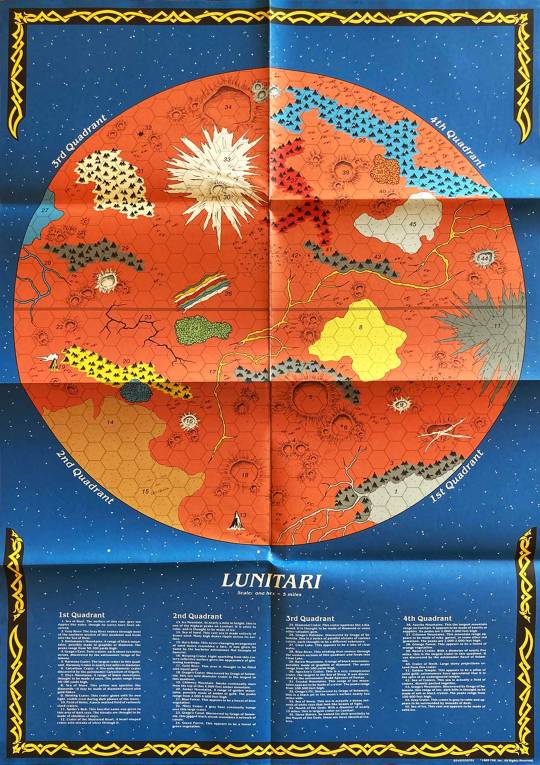
Everyone’s gone to the moon -- Map to adventure on the surface of Lunitari, the red moon of Krynn, one of three moons in the world of Dragonlance (AD&D 2e module DLE3: Dragon Keep by Rick Swan, cartography credited to Diesel -- David S LaForce, TSR, 1989)
#D&D#Dungeons & Dragons#David S LaForce#D&D map#Dragonlance#Diesel#Dragon Keep#Lunitari#Krynn#AD&D#AD&D 2e#dnd#Rick Swan#moon#Dungeons and Dragons#TSR#1980s
94 notes
·
View notes
Text
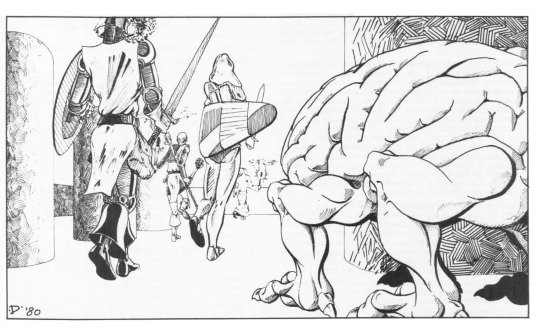
Adventure S3 Expedition to the Barrier Peaks
Art: David S. LaForce
#dnd#dnd art#dungeons and dragons#d&d#advanced dungeons and dragons#old school#role playing games#rpg#ttrpg
4 notes
·
View notes
Photo

Enjoying a late summer evening outdoors -- Nnuuurrrr’c’c, demigod, master of the insect swarm, the King with Wings, has a 140′ wingspan and is worshipped by all insect races (tiny thumbnail illustration by Diesel / David S LaForce from the Melnibonéan mythos in early printings of AD&D Deities & Demigods, TSR, 1980)
#D&D#Dungeons & Dragons#David S LaForce#Diesel#Deities & Demigods#AD&D#Nnuuurrrr'c'c#dnd#Dungeons and Dragons#Michael Moorcock#Elric#Melnibonean mythos#giant insect#demigod#deity#mosquito#Melnibone#Elric of Melnibone#Melniboné#TSR
91 notes
·
View notes